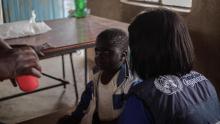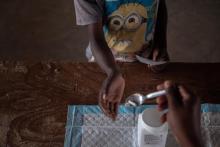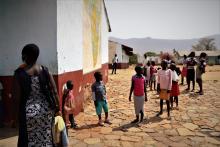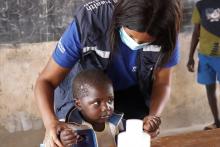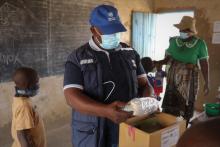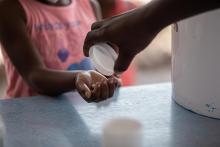300 000 people to receive free treatment for bilharzia and intestinal worms in Mount Darwin and Shamva
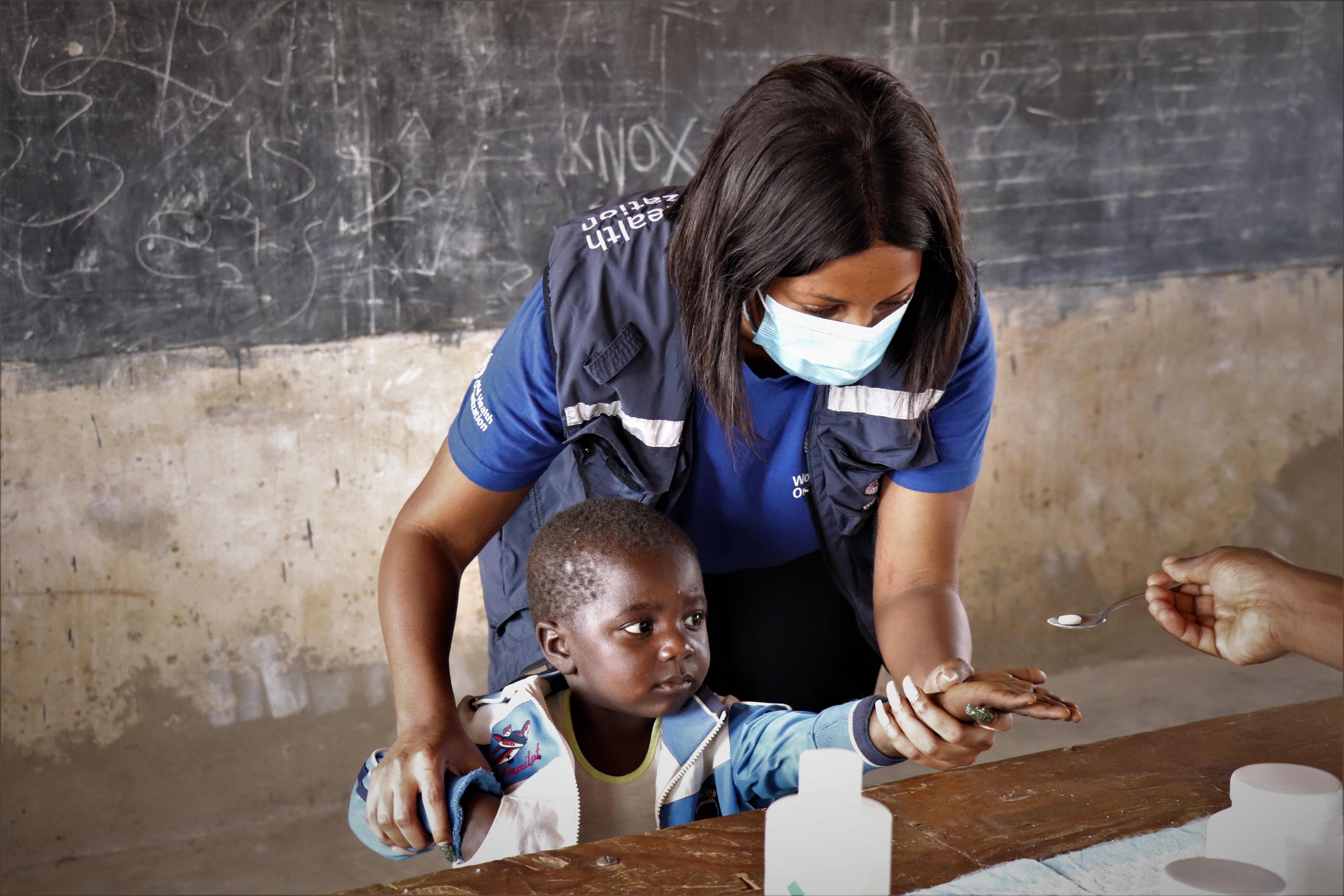
By Roselyne Sachiti and Tatenda Chimbwanda
Mount Darwin, Zimbabwe- Michelle and Munashe Butao are twelve-year-old twins whose resemblance is quite striking. Both shy and passionate about school as well as doing household chores, the two are always together and are in the same Grade 4 class at Nyamaswavo Primary School in Mount Darwin, Mashonaland Central Province.
The day is September 21, 2020 and the pair -both holding plastic containers- stand in a long meandering queue at Chitse Clinic in Mudzengerere Village under chief Dotito, Mount Darwin.
At this static centre, hundreds other children between 1 and 15 years maintain social distancing as they patiently wait for their turn to have their height measured by a nurse. The height of each child will determine the dose of deworming medicines- praziquantel and albendazole- being freely distributed through the Ministry of Health and Child Care (MoHCC) led National Mass Treatment Campaign for bilharzia and intestinal worms, also known as Mass Drug Administration (MDAs), which will run until 30 September 2020.
“My twin and I both have bilharzia. We are excited to get deworming pills. I am happy that the treatment is free,” reveals Munashe the chattier of the pair.
As his hands are being sanitised by a Village Health Worker (VHW) at the entrance to the open space being used, his attention is focused on his sister who is in front. Her height is now being measured and from there she will wash her hands with running water near where the pills are being given out.
Munashe shyly says, “he does not remember how many times he has had bilharzia. He is sure his love of swimming in the Ruya River exposed him to the tiny worms or flukes that are shed by freshwater snails. Many times he has been in trouble with his mother after she caught him taking an unsanctioned dive.”
Schistosomiasis (also known as bilharzia) is a vector-borne parasitic disease caused by trematode flatworms of the genus Schistosoma. Freshwater snails act as the vector, releasing larval forms of the parasite into water. These larvae subsequently penetrate the skin of people who are in that water.
“Our mother taught us to detect symptoms of bilharzia early such as blood in my urine so whenever I notice such, I tell her immediately. She also told us not to swim in stagnant water which has algae, but I keep going back,” he confesses.
Even with enough knowledge, Munashe and his friends are sometimes too daring. The temperatures here are blistering and the young boys cannot resist the temptation of soothing their sunburnt skin with a splash in the cool water. He is happy that the MDAs came when he had bilharzia symptoms. His sister Michelle is also happy to receive free treatment.
At a mobile centre at Mudzengerere Secondary School, about a kilometre from Chitse clinic, nurses take turns to help children take their medicines. At another mobile centre, Kajokoto Primary School in Dotito village, VHWs help out nurses from the MoHCC and Zimbabwe Republic Police (ZRP) administer treatment to the children.
The same routine and WHO Infection Prevention and Control (IPC) guidelines being followed at Chitse Clinic and other mobile and static centres around the province are also being applied here. Sister in charge at Chitse Clinic, Joyce Vumbunu said they are using the knowledge they received at a recent training in Mount Darwin to administer MDAs in the COVID context.
According to Joyce, bilharzia is prevalent in their area. “Whenever we do our monthly statistics, bilharzia frequently tops the list. Most people are into gold panning and get infected during the process as they will not be wearing any protective shoes. I have been working here for 11 years. On average we receive 50 cases per month. This includes children and even adults in their sixties. Young boys also get infected and re-infected regularly,” she discloses.
In this part of Zimbabwe, bilharzia cases go down whenever National Mass Treatment Campaigns like the current one are done, but escalate during the farming season and this worries Joyce.
However, she is happy that a two-day workshop she attended in Mount Darwin between 9 and 10 September 2020 in preparation of the National Mass Treatment Campaign gave her new insights especially during the Covid-19 era. A similar training was also conducted in Shamva between 11 and 12 September 2020.
Joyce was part of the 155 health workers trained with financial support from WHO. “The training was empowering. As part of precautions in the Covid-19 context, we made sure we have sanitisers and buckets of water with taps. I was also happy when they told us to advise everyone to bring their own cup or empty container with safe drinking water to avoid sharing. All the children we are attending to here brought their own containers,” she notes.
Adds Joyce: “I learnt of WHO COVID-19 IPC measures at the training. As a result, we have been telling the children to maintain social distancing and also wear masks. We advise those without masks to find even some wrap around cloth to cover their mouth and nose.”
Early in the Covid-19 pandemic, Mount Darwin, Shamva and the rest of the districts in Zimbabwe had suspended community-based interventions against Neglected Tropical Diseases (NTDs) and were relying on health facilities-based services. With information showing that the pandemic was far from over, and the need to continue essential health services, WHO released recommendations for NTDs interventions in the context of COVID-19. The recommendations focused on outlining the measures health workers should follow in order to protect themselves and the communities they will be serving from contracting COVID-19. Some of the key recommendations also included precautionary measures to take into account when identifying a distribution point venue which has sufficient space for the expected number of people, and if indoors, use of the most well-ventilated areas available.
These recommendations brought the need to train Shamva`s and Mount Darwin’s health care workers prepare to conduct the current National Treatment Campaign outreaches in their various catchment areas within the districts.
Perseverance Chitate, a nurse from Madziva Rural Hospital in Shamva who attended the training explains how the workshop taught her ways to coordinate and, most importantly, integrate COVID-19 precautions and MDAs.
“The campaign started on the 21st and will run till 30 September 2020. What we have observed during the rounds we made to all the stations where activities are taking place is that there was enough preparation and organization as a result of the training,” noted WHO National Professional Officer, Casper Tarumbwa.
He further explains: “Today did not seem like it was the first day of implementation. Normally the first day is fraught with hiccups and delays, but we are impressed that the people were well prepared. The turnout was good, they were observing IPC measures like sanitisation of surfaces, handwashing of children who were receiving the medication. We also noticed that essential services were continuing and had not been stopped because of the MDAs. It seems people got the message during the training. We are quite impressed by the compliance with IPC measures and the smooth flow of activities.”
He further expounded that community mobilisation was successful because all the key stakeholders for example, VHWs, School Heads/teachers, Nurses, Political and community Leaders, and ZRP participated in the MDA and worked in unison.
“For example, we had a senator who availed his own personal vehicle for use at Kajokoto primary school. Health workers from the police also assisted during the exercise,” he further articulated.
Mashonaland Central Provincial Epidemiology and Disease Control Officer, Dr Stanley Tapesana, pronounced that WHO is supporting disease control interventions in the province.
“Some of the interventions include the MDAs we are currently running in Mount Darwin and Shamva districts. As far as the response to Covid-19 is concerned, WHO is also supporting the coordination of all the pillars in the response. There is financial, capacity building and technical support. WHO has been key in strengthening the response capacities for health activities within our province,” he explained.
National Mass Treatments are part of MoHCC bilharzia and intestinal worm’s elimination strategy which began in 2010. Zimbabwe has been conducting the campaigns for the past seven years in 57 endemic districts, out of the 63 rural based districts, and in metropolitan provinces including, Harare, Chitungwiza and Bulawayo. WHO has been providing deworming medicines (praziquantel and albendazole) annually for over seven successive years in these districts. The National Mass Treatments remain guided by WHO strategies to address the burden of NTDs, through preventive chemotherapy. Preventive chemotherapy is administered on the assumption that everyone in high burdened areas has the disease and receives medication. That way the community is protected against further infection because the number of people who shed bilharzia or intestinal worms into the water or soil is reduced.
WHO is financially supporting the direct implementation of the National Mass Treatment Campaign for bilharzia and intestinal worms in Shamva and Mount Darwin. The MDAs are targeting mainly 1-15 years olds and not less than 300 000 are set to get treatment in the two districts. Moreover, Higher Life Foundation (HLF) will provide similar support to the remaining 54 districts with WHO providing them with free medication and technical guidance.
The support WHO is rendering to MoHCC, including free deworming medicines in Zimbabwe, was made possible by financial support from Expanded Special Project for Elimination (ESPEN) of NTDs project in WHO AFRO. The project pools funds from donors to support countries in the control and elimination of NTDs, particularly those that require regular administration of medicines as a key intervention towards their control and elimination. This activity falls under the framework of WHO Zimbabwe’s Country Support Plan for 2020-21, with one of the key interventions in the NTDs program being supporting annual MDAs for bilharzia and intestinal worms.
In Zimbabwe the two NTDs of public health significance are bilharzia and intestinal worms. Bilharzia ranks among the top ten causes of hospital admissions in the country. Although Zimbabwe has not eliminated bilharzia completely, the country has made great progress in reducing the burden as a result of the National Treatment Campaigns conducted every year. MDAs ensure people in hard to reach places receive the deworming medication without necessarily having to walk long distances to access the service.
Consequently, under the MoHCC leadership, Zimbabwe has managed to provide access to praziquantel and albendazole to all infected people regardless of age (living no-one out). According to the MDA impact assessment done in 2018, Zimbabwe has had an 78.3% prevalence reduction of bilharzia. This is down from a national prevalence of 23% in 2010 to 5% in 2018. It appears the country is on course to fulfil one of the United Nations` Sustainable Development Goals (SDG 3) whose objective is promoting good health and wellbeing within communities. SDG 3, subsection 3.3, places emphasis on ending epidemics of NTDs, among other diseases. In Africa, WHO seeks to attain this goal by translating into action the WHO Global Roadmap for NTDs through the Regional Strategic Plan for NTDs 2014-20, which includes the control and elimination of bilharzia and intestinal worms.
Roselyne Sachiti is the Features, Health and Society Editor of The Herald Zimbabwe
Tatenda Chimbwanda is the Communications Officer, WHO Zimbabwe
Communications Officer
Tel: + 263 914 31408
Email: juliasw [at] who.int (juliasw[at]who[dot]int)



